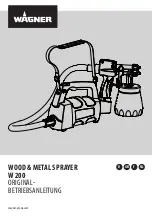
SATA HKU | 10
b) Inlet valve on the pick-up tube.
c) All fixation screws (2 x 4 screws) of the compressed air
motor.
d) All hose and material conduit connections.
7.4 Service and Maintenance
1. General Advice
1.1 For your ownl safety, disconnect the compressed air motor
from the air line and release the system pressure com
-
pletely, prior to any service and maintenance work, except
in case of a test run which then needs to be carried out with
utmost care.
1.2 All screws and threaded connections are executed as right-
handed threads, unless otherwise indicated.
1.3 Avoid scratches and damage on packings and anti-friction
surfaces. When servicing the pump, all components must
be protected from dust and dirt, especially the cylinder walls
and the central bar. Keep the working area and tools clean.
1.4 Disassemble and assemble O-rings and packings with
utmost care. Worn-out or damaged sealing elements must
be always replaced, in particular O-rings that are worn-out,
deformed or have lost their elasticity.
1.5 Clean sealing and sliding surfaces before applying some
grease (Art. No. 48173) prior to their reassembly, particularly
on O-rings and packings.
1.6 To clean the components, use Varnolen or similar oil-based
cleaning media. If water-based cleaning fluids are being
used, all components must be thoroughly wiped dry imme
-
diately afterwards to prevent corrosion.
2.
Air Motor
2.1 Fixate the outlet housing of the pump in a vise, with the pick-
up tube directed to the floor. Loosen the four screws (Pos.
2) on the air cylinder (Pos. 7) to remove the cylinder from
the outlet housing.
2.2 Check the packings (Pos. 5) if worn or damaged. All sealing
lips, whether it be the smaller ones inside the mechanism or
the larger ones that seal against the cylinder wall, need to
be fully intact.
2.3 Make sure that no oil or spraying medium has penetrated
the packing sleeve (Pos. 9) located above the packings
(Pos. 15).
2.4 When the packing (Pos. 8) or the mechanism (Pos. 5) need
to be replaced, the central bar (Pos. 16) must be pulled out
until the purging hole in the central bar is visible through
the ventilation hole of the packing sleeve (Pos. 9). Insert
a screwdriver or similar tool into the hole and loosen the
mechanism with the help of the supplied special tool (Pos.
1). Alternatively, the mechanism can be also fixated with a
cloth or a work glove, should the special tool be no longer
available. Proceed with care to prevent scratches or dam
-
age on the surface of the central bar.
2.5 Loosen the mechanism (Pos. 5) which should be seated
rather tight. Pull the packing sleeve in the upward direction
in order to be able to examine the surface of the central bar
and to remove the packing. In case that the bottom pack
-
ing needs to be inspected, remove the central bar from the
bottom part. To do this, remove the pin (Pos. 18) and disas
-
semble the central bar from the lower piston rod (Pos. 6).
Attention! The packings of the central bar must be thor-
oughly checked for wear. Scratches and dents on the
sliding surfaces of the central bar will cause leakage
and malfunction of the pump.
2.6 Replace worn parts and reassemble all components in
reverse order.
2.7 Important!
Ensure to apply grease (Art. No. 48173) on all
sliding and packing surfaces before reassembly.
3.
Pump Pipe
3.1 Fixate the outlet housing of the pump in a vise, with the
pick-up tube in horizontal position. Remove the pick-up tube
(Pos. 4) with a strap wrench. Do not use a pipe wrench
which could damage the tube.
3.2 Pull off the pick-up tube, check the piston packings (Pos. 10)
and replace them in case they are worn or damaged.
3.3 Proceed carefully to prevent particles and dirt from clogging
inside or on the piston. Replace all worn or damaged parts.
3.4 The inlet valve (Pos 14) can be removed to check whether
dirt or other contamination may have deposited inside the
valve. When the inlet valve is removed for inspection, the
O-ring (Pos 12) between the inlet valve and the pick-up tube
must be replaced.
EN
Содержание HKU
Страница 21: ...SATA HKU 21 8 EN...











































